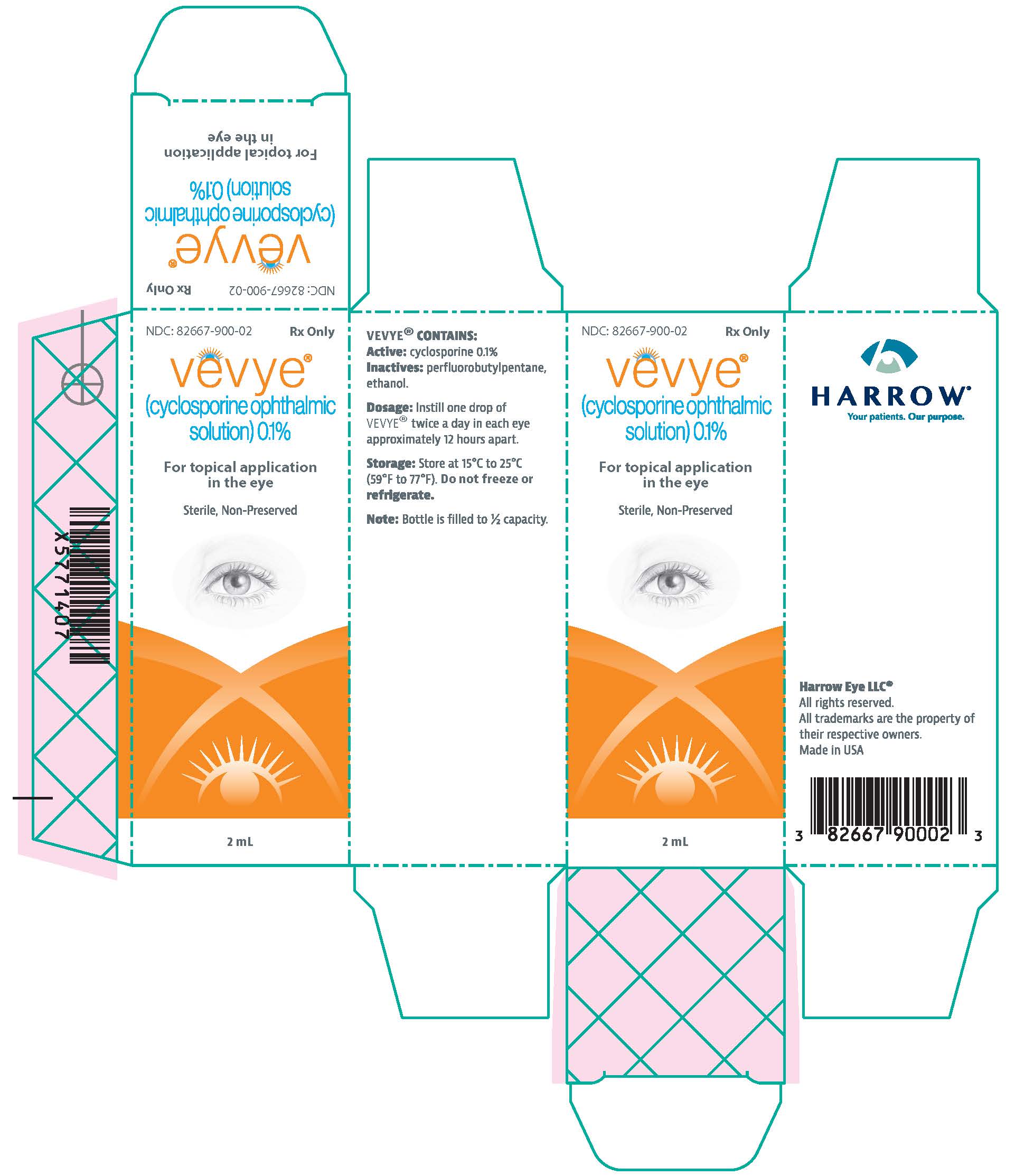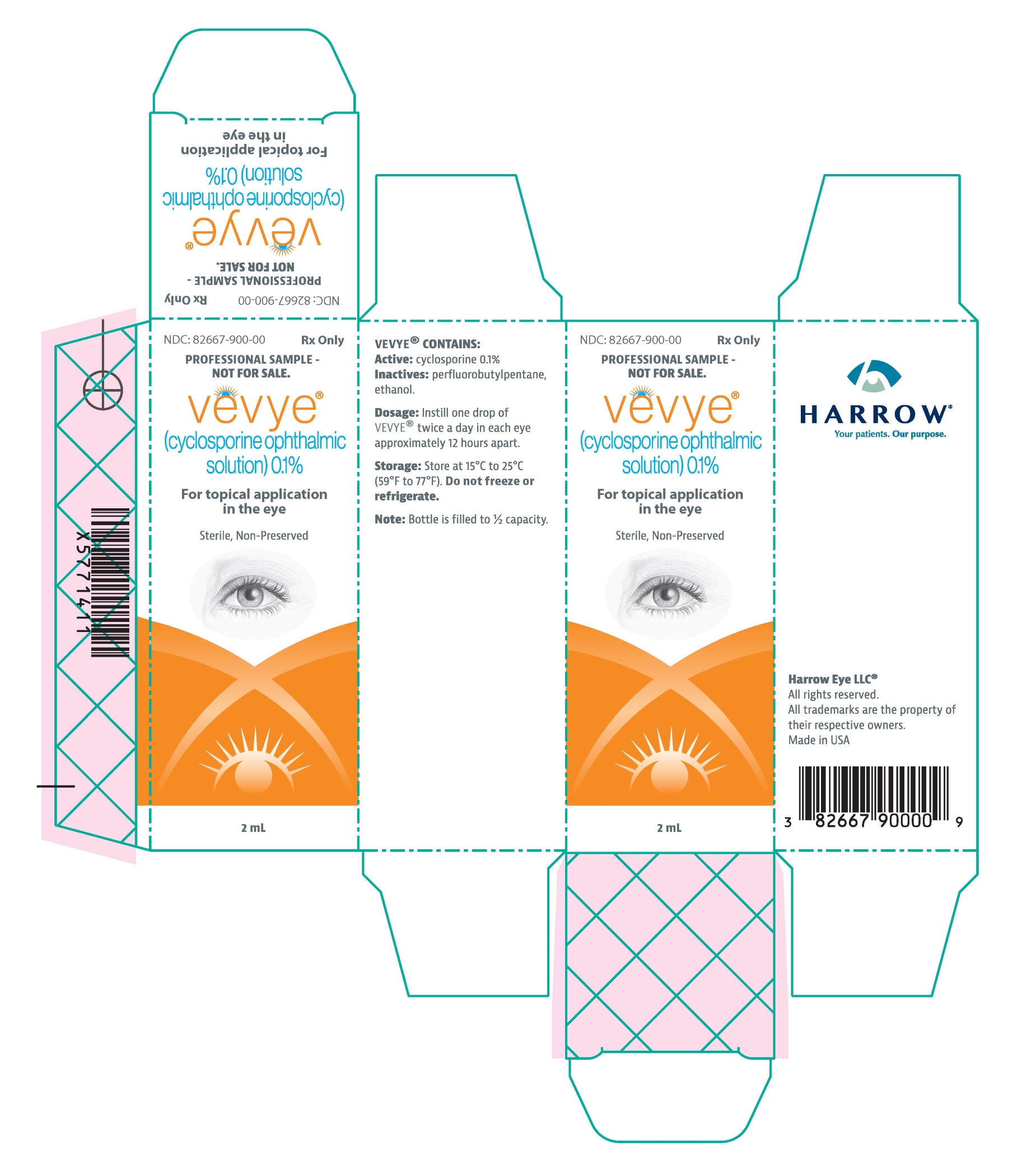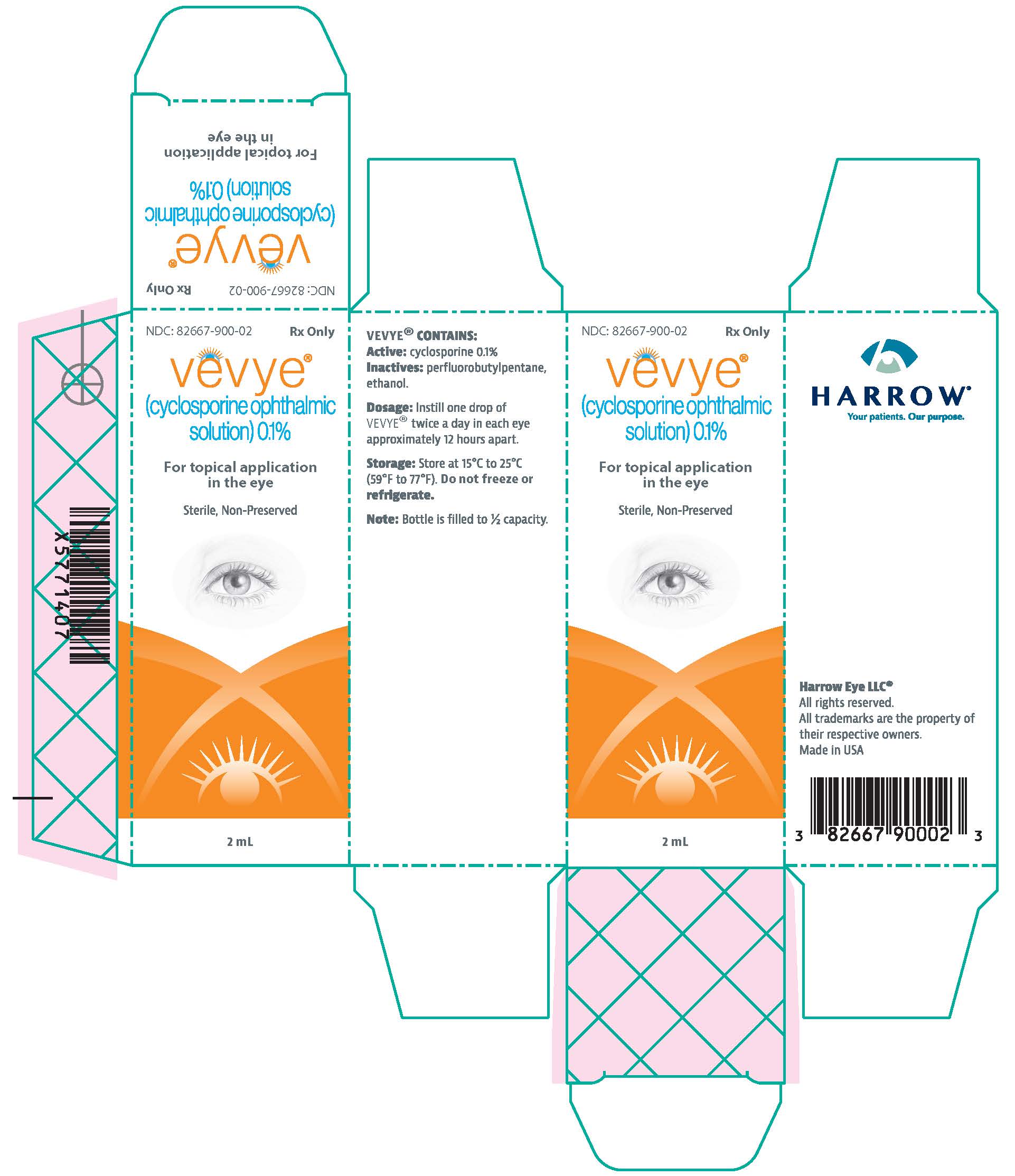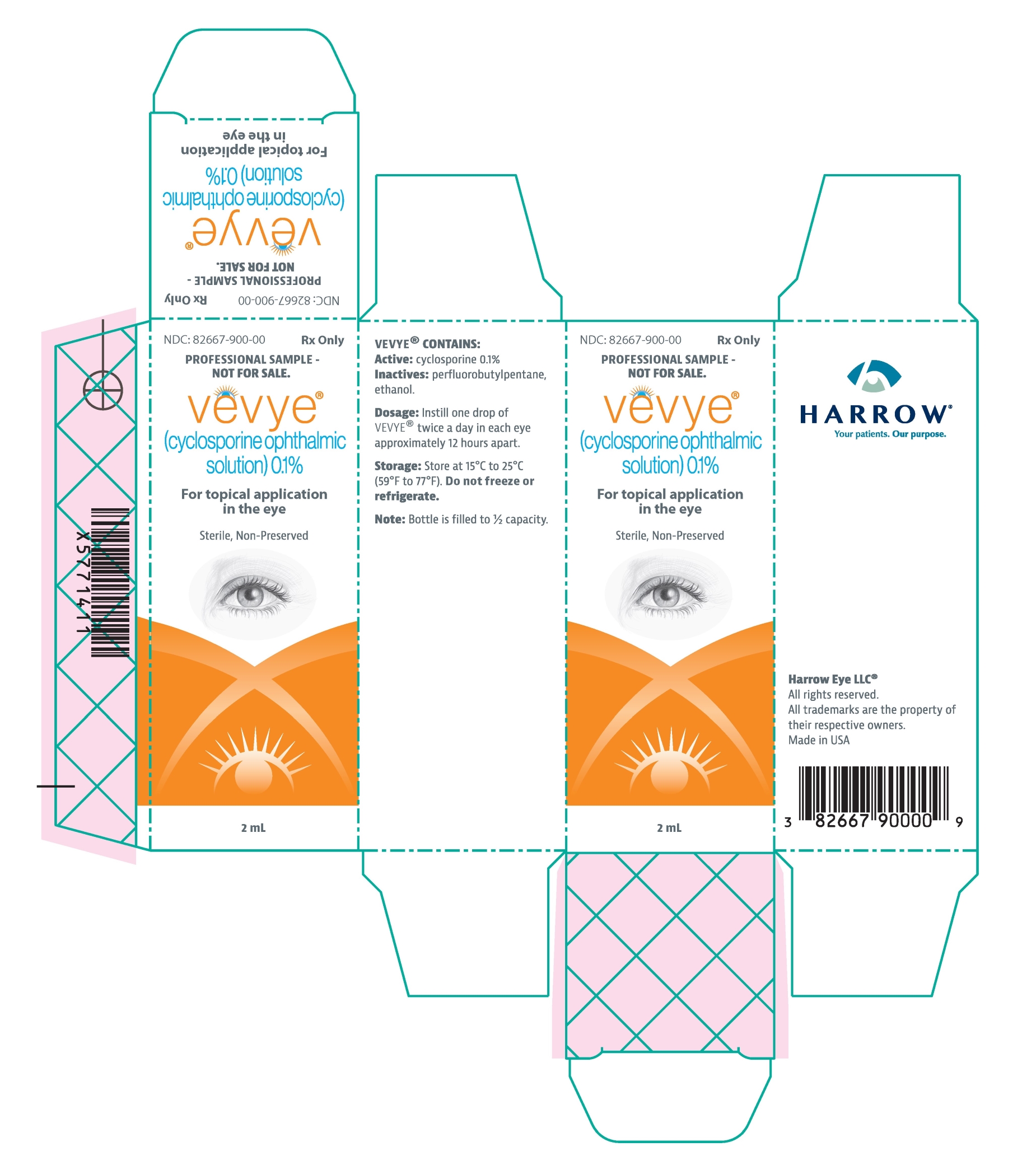Label: VEVYE- cyclosporine ophthalmic solution solution/ drops
- NDC Code(s): 82667-900-00, 82667-900-02
- Packager: Harrow Eye, LLC
- Category: HUMAN PRESCRIPTION DRUG LABEL
- DEA Schedule: None
- Marketing Status: New Drug Application
Drug Label Information
Updated November 21, 2023
If you are a consumer or patient please visit this version.
- Download DRUG LABEL INFO: PDF XML
- Official Label (Printer Friendly)
-
HIGHLIGHTS OF PRESCRIBING INFORMATION
These highlights do not include all the information needed to use VEVYE ® safely and effectively. See full prescribing information for VEVYE.
VEVYE (cyclosporine ophthalmic solution) 0.1%, for topical ophthalmic use
Initial U.S. Approval: 1983INDICATIONS AND USAGE
VEVYE (cyclosporine ophthalmic solution) 0.1% is a calcineurin inhibitor immunosuppressant indicated for the treatment of the signs and symptoms of dry eye disease. ( 1)
DOSAGE AND ADMINISTRATION
Instill one drop of VEVYE twice a day in each eye approximately 12 hours apart. ( 2)
DOSAGE FORMS AND STRENGTHS
Ophthalmic solution containing cyclosporine 0.1%. ( 3)
CONTRAINDICATIONS
None. ( 4)
WARNINGS AND PRECAUTIONS
Care should be taken to not touch the eye or other surfaces with the bottle tip to avoid potential for eye injury and/or contamination. ( 5.1)
ADVERSE REACTIONS
The most common adverse reaction following the use of VEVYE were instillation site reactions (8%). ( 6.1)
To report SUSPECTED ADVERSE REACTIONS, ccontact Harrow Eye, LLC ® at 833-4HARROW or FDA at 1-800-FDA-1088 or www.fda.gov/medwatch.
Revised: 11/2023
-
Table of Contents
FULL PRESCRIBING INFORMATION: CONTENTS*
1 INDICATIONS AND USAGE
2 DOSAGE AND ADMINISTRATION
3 DOSAGE FORMS AND STRENGTHS
4 CONTRAINDICATIONS
5 WARNINGS AND PRECAUTIONS
5.1 Potential for Eye Injury and Contamination
5.2 Use with Contact Lenses
6 ADVERSE REACTIONS
6.1 Clinical Trials Experience
8 USE IN SPECIFIC POPULATIONS
8.1 Pregnancy
8.2 Lactation
8.4 Pediatric Use
8.5 Geriatric Use
11 DESCRIPTION
12 CLINICAL PHARMACOLOGY
12.1 Mechanism of Action
12.3 Pharmacokinetics
13 NONCLINICAL TOXICOLOGY
13.1 Carcinogenesis, Mutagenesis, Impairment of Fertility
14 CLINICAL STUDIES
16 HOW SUPPLIED/STORAGE AND HANDLING
- *
- Sections or subsections omitted from the full prescribing information are not listed.
- 1 INDICATIONS AND USAGE
- 2 DOSAGE AND ADMINISTRATION
- 3 DOSAGE FORMS AND STRENGTHS
- 4 CONTRAINDICATIONS
- 5 WARNINGS AND PRECAUTIONS
-
6 ADVERSE REACTIONS
6.1 Clinical Trials Experience
Because clinical trials are conducted under widely varying conditions, adverse reaction rates observed in the clinical trials of a drug cannot be directly compared to rates in the clinical trials of another drug and may not reflect the rates observed in practice.
In clinical trials with 738 subjects receiving at least 1 dose of VEVYE, the most common adverse reactions were instillation site reactions (8%) and temporary decreases in visual acuity (3%).
-
8 USE IN SPECIFIC POPULATIONS
8.1 Pregnancy
Risk Summary
There are no adequate and well-controlled studies of VEVYE administration in pregnant women to inform a drug-associated risk. Oral administration of cyclosporine to pregnant rats or rabbits did not produce teratogenicity at clinically relevant doses. VEVYE doses are approximately 4,700 times lower than recommended oral doses, with blood concentrations being undetectable after topical administration.Data
Animal Data
Oral administration of cyclosporine oral solution to pregnant rats or rabbits was teratogenic at maternally toxic doses of 30 mg/kg/day in rats and 100 mg/kg/day in rabbits, as indicated by increased pre- and postnatal mortality, reduced fetal weight and skeletal retardations. These doses (normalized to body weight) were approximately 7,250 and 48,000 times higher than the daily maximum recommended human ophthalmic dose (MRHOD) of 0.67 mcg/kg/day, respectively.No adverse embryofetal effects were observed in rats or rabbits receiving cyclosporine during organogenesis at oral doses up to 17 mg/kg/day or 30 mg/kg/day, respectively (approximately 4,100 and 14,500 times higher than the MRHOD, respectively).
An oral dose of 45 mg/kg/day cyclosporine (approximately 10,900 times higher than MRHOD) administered to rats from Day 15 of pregnancy until Day 21 postpartum produced maternal toxicity and an increase in postnatal mortality in offspring. No adverse effects in mothers or offspring were observed at oral doses of up to 15 mg/kg/day (3600 times greater than MRHOD).
8.2 Lactation
Risk Summary
Cyclosporine is known to be excreted in human milk following systemic administration but excretion in human milk after topical treatment has not been investigated. VEVYE doses are approximately 4,700 times lower than recommended oral doses of cyclosporine, with blood concentrations being undetectable after topical administration. However, caution should be exercised when VEVYE is administered to a nursing woman. -
11 DESCRIPTION
VEVYE (cyclosporine ophthalmic solution) 0.1% contains the immunomodulatory agent cyclosporine. Cyclosporine’s chemical name is Cyclo[[(E)-(2S,3R,4R)-3-hydroxy-4-methyl-2-(methylamino)-6-octenoyl]-L-2-aminobutyryl-N-methylglycyl-N-methyl-L-leucyl-L-valyl-N-methyl-L-leucyl-L-alanyl-D-alanyl-N-methyl-L-leucyl-N-methyl-L-leucyl-N-methyl-L-valyl] and it has the following structure:
Structural Formula
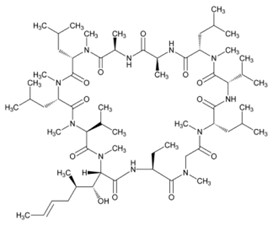
Formula: C 62H 111N 11O 12, Molecular weight: 1202.6
Cyclosporine is a white powder that is soluble in perfluorobutylpentane. VEVYE is supplied as a 2 mL sterile, clear, colorless, non-aqueous ophthalmic solution for topical ophthalmic use.
VEVYE contains:
• Active: cyclosporine 0.1%
• Inactives: perfluorobutylpentane, ethanol (anhydrous).
The solution does not contain water or anti microbial preservatives. As a water free product, there is no associated pH and no osmolarity. - 12 CLINICAL PHARMACOLOGY
-
13 NONCLINICAL TOXICOLOGY
13.1 Carcinogenesis, Mutagenesis, Impairment of Fertility
Carcinogenesis
Evaluation of the potential carcinogenicity of cyclosporine was conducted in male and female mice and rats. In a 78-week oral (diet) mouse study, at doses of 1, 4, and 16 mg/kg/day, evidence of a statistically significant trend was found for lymphocytic lymphomas in females, and the incidence of hepatocellular carcinomas in mid dose males significantly exceeded the control value.In a 24-month oral (diet) rat study, conducted at 0.5, 2, and 8 mg/kg/day, pancreatic islet cell adenomas significantly exceeded the control rate in the low dose level. The hepatocellular carcinomas and pancreatic islet cell adenomas were not dose related. The low doses in mice and rats were approximately 120 times higher than the maximum recommended human ophthalmic dose (0.67 mcg/kg/day), normalized to body surface area.
Mutagenesis
In genetic toxicity tests, cyclosporine has not been found to be mutagenic/genotoxic in the Ames Test, the V79 HGPRT Test, the micronucleus test in mice and Chinese hamsters, the chromosome-aberration tests in Chinese hamster bone-marrow, the mouse dominant lethal assay, and the DNA-repair test in sperm from treated mice. Cyclosporine was positive in an in vitro sister chromatid exchange (SCE) assay using human lymphocytes.Impairment of Fertility
Oral administration of cyclosporine to rats for 12 weeks (male) and 2 weeks (female) prior to mating produced no adverse effects on fertility at doses up to 15 mg/kg/day (approximately 3,600 times higher than the maximum recommended human ophthalmic dose). -
14 CLINICAL STUDIES
The safety and efficacy of VEVYE were assessed in a total of 1369 patients with dry eye disease, of which 738 received VEVYE.
In two multicenter, randomized, adequate and well-controlled clinical studies, patients with dry eye disease (CYS-002: NCT02617667 and CYS-004: NCT04523129), treated with VEVYE were compared to patients treated with vehicle. At Day 29, there was a statistically significant higher percentage of eyes with increases of ≥ 10 mm from baseline in Schirmer’s wetting. This effect was seen in approximately 10% of VEVYE-treated patients versus approximately 6% of vehicle-treated patients.
Percent of Patients Achieving ≥ 10 mm Improvement from Baseline in Schirmer’s Tear Test Score in Study Eyes in Patients with Dry Eye Disease CYS-002
Day 29CYS-004
Day 29VEVYE
N=51Vehicle
N=51VEVYE
N=409Vehicle
N=395≥ 10 mm increase in tear production (% patients) 8% 0% 11% 7% Difference (95% CI) 7.8% (0.5%, 15%) 3.9% (0.02%, 7.8%) p-value versus vehicle 0.04 0.05 -
16 HOW SUPPLIED/STORAGE AND HANDLING
VEVYE is a sterile, clear, colorless, non-aqueous, non-preserved ophthalmic solution packaged in multiple-dose eye drop bottles delivering single drops of approximately 0.01 mL volume. Each unit contains 2 mL of VEVYE in a 5 mL transparent squeezable polypropylene bottle with a transparent polyethylene tip and a white polyethylene cap with tamper-evident ring.
Commercial NDC: 82667-900-02
Sample NDC: 82667-900-00Storage and Handling
Do not use if tamper-evident ring attached to the white cap is not intact. After first opening the tamper-evident ring of the cap remains on the bottle neck. Retain the cap and keep the bottle tightly closed when not in use.Store at 15°C to 25°C (59°F to 77°F). Do not freeze or refrigerate. After opening, VEVYE can be used until the expiration date on the bottle.
-
17 PATIENT COUNSELING INFORMATION
Risk of Contamination
Advise patients to wash their hands well before each use. Advise patients not to allow the dropper tip to touch the eye or any other surface, as this may contaminate the solution [ see Warning and Precautions ( 5.1) ].
Contact Lens Wear
Contact lenses should be removed prior to instillation of VEVYE and may be reinserted 15 minutes following administration [ see Warning and Precautions ( 5.2) ]. - SPL UNCLASSIFIED SECTION
- PRINCIPAL DISPLAY PANEL - CARTON
- PRINCIPAL DISPLAY PANEL - SAMPLE CARTON
-
INGREDIENTS AND APPEARANCE
VEVYE
cyclosporine ophthalmic solution solution/ dropsProduct Information Product Type HUMAN PRESCRIPTION DRUG Item Code (Source) NDC:82667-900 Route of Administration OPHTHALMIC Active Ingredient/Active Moiety Ingredient Name Basis of Strength Strength CYCLOSPORINE (UNII: 83HN0GTJ6D) (CYCLOSPORINE - UNII:83HN0GTJ6D) CYCLOSPORINE 1 mg in 1 mL Inactive Ingredients Ingredient Name Strength 1,1,1,2,2,3,3,4,4-NONAFLUORONONANE (UNII: M4M23ZL2AD) 1276.5 mg in 1 mL ALCOHOL (UNII: 3K9958V90M) 12.9 mg in 1 mL Packaging # Item Code Package Description Marketing Start Date Marketing End Date 1 NDC:82667-900-02 1 in 1 CARTON 12/01/2023 1 2 mL in 1 BOTTLE, DROPPER; Type 0: Not a Combination Product 2 NDC:82667-900-00 1 in 1 CARTON 12/01/2023 2 2 mL in 1 BOTTLE, DROPPER; Type 0: Not a Combination Product Marketing Information Marketing Category Application Number or Monograph Citation Marketing Start Date Marketing End Date NDA NDA217469 05/30/2023 Labeler - Harrow Eye, LLC (118526951)

